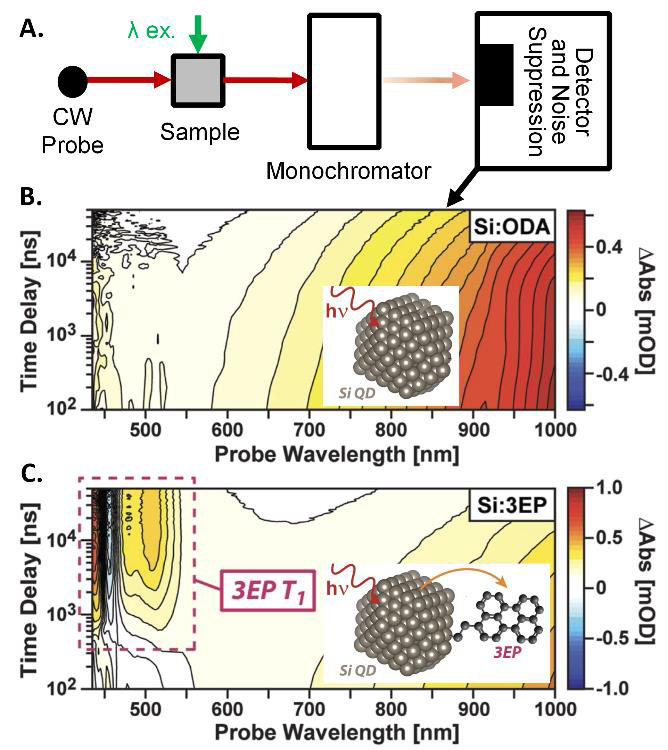See how triplet energy exchange (TEE) measured with an enVISionTM spectrometer can enable efficient upconversion to harvest more energy from the sun in solar energy research.
Triplet Exchange and Upconversion Revealed by Transient Absorption Spectroscopy
Table of Contents
ABSTRACT: The ability to acquire full spectra and kinetics with ultrahigh sensitivity enabled by recent advances in noise suppression technology from Magnitude Instruments has fundamentally changed transient absorption (TA) spectroscopy measurements. A team of researchers at the University of Texas, Austin and the University of California, Riverside recently used the enVISionTM spectrometer to directly observe bidirectional triplet energy exchange between Si nanocrystals and triplet energy acceptors that led to efficient upconversion of low energy near-infrared light to high energy blue light for solar energy harvesting and optoelectronics applications.
A team of investigators led by Professor Ming Lee Tang at the University of California, Riverside (now at the University of Utah) and Professor Sean Roberts at the University of Texas, Austin used the fast data acquisition capability of an enVISionTM transient absorption (TA) spectrometer from Magnitude Instruments to reveal bidirectional triplet energy exchange in a hybrid material consisting of silicon nanocrystals bonded to molecular triplet energy acceptors.1 The investigators demonstrated the ability to upconvert two low energy 730 nm photons into a higher energy 475 nm photon in a proof-of-concept experiment to show the viability of the upconversion process to enhance the efficiency with which sunlight can be converted to electricity or fuels. Their work demonstrates that it is possible to extend the long wavelength region of the solar spectrum that can be harvested for solar energy applications.
The significance of this scientific advance relates to the maximum theoretical power conversion efficiency of silicon photovoltaic devices that is limited to about 31%, largely because excess energy is dissipated as heat from short wavelength photons with energy greater than the bandgap of silicon. Semiconductors with wider bandgaps can preserve more energy of the shorter wavelength photons but do not absorb enough of the solar spectrum to reach higher efficiencies. This compromise between the fraction of the solar spectrum absorbed versus the fraction of energy lost as heat leads to the maximum theoretical power conversion efficiency of single-junction photovoltaic devices known as the Shockley–Queisser limit.
The upconversion process demonstrated by Tang, Roberts and their team offers a promising approach to overcome the Shockley–Queisser limit and enhance the theoretical efficiency of silicon photovoltaics above 40% by enabling more of the solar spectrum to be captured without the corresponding energy losses due to heat caused by the use of lower bandgap semiconductors. Key to their success was the ability to measure both the transient absorption spectra and the time evolution of the transient excited states with high resolution in both the frequency and time domains. Figure 1A depicts the optical layout of the enVISionTM spectrometer used in the measurements. The transient absorption data in Figure 1B displays the broad absorption of photoexcited carriers in the silicon nanocrystals that persist for many microseconds in the absence of triplet energy acceptors. With the attachment of triplet energy acceptors onto the nanocrystals, energy transfer created excited states on the acceptors with a unique absorption band around 500 nm that appears in the 2D-TA data in Figure 1C (3EP T1).

Figure 1. A. Schematic of the transient absorption method in the enVISionTM spectrometer from Magnitude Instruments. B. Wavelength-time nanosecond TA spectra of silicon quantum dots (QDs). C. TA data of silicon QDs with attached triplet energy acceptors (3EP). The combined wavelength and time domain data in the TA maps reveal rapid triplet energy exchange between silicon and 3EP acceptors that enables upconversion of two low energy photons to form one high energy exciton in the perylene emitters. The authors used this measurement capability to demonstrate the potential to utilize upconversion to harvest the low energy portion of the solar spectrum for more efficient solar energy conversion. Adapted from Chem. Sci. 2021,12,6737-6746. Licensed under CC BY-ND 3.0.
Because the noise suppression technology from Magnitude Instruments enables measurement of the complete time axis with every laser shot, the investigators were able to capture the time evolution of the excited states with sufficient fidelity to demonstrate that the energy transfer process could not be described by a single step. The investigators used the enVISionTM spectrometer to demonstrate for the first time that rapid bidirectional triplet energy exchange occurred between the silicon nanocrystals and the molecular triplet energy acceptors. This exchange was essential to allow two triplet excited states to reside on the same triplet acceptor long enough for them to fuse into one high energy excited state – leading to the upconversion process and emission of a higher energy 475 nm photon from absorption of two lower energy 730 nm photons. By examining the detailed time-dependence of the triplet energy exchange process read out through the high fidelity TA measurements, the investigators were able to establish design rules about how to control the bidirectional exchange to enhance the efficiency of the upconversion process for high performance photovoltaic devices capable of exceeding the Shockley-Queisser limit.
REFERENCES
- Huanget al. Chem. Sci.(2021) DOI: 10.1039/d1sc00311a.

SHARE